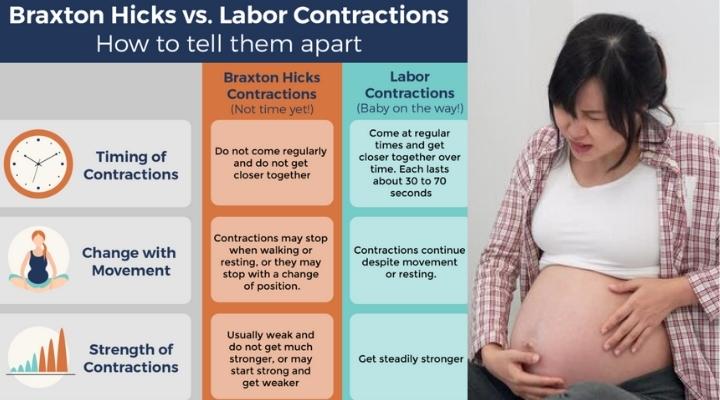How to distinguish between False Pain & True Labor Pain
Pregnancy and childbirth are undoubtedly one of the most significant and transformative experiences in a woman’s life. In this comprehensive guide, we will get to know How to distinguish between False Pain & True Labor Pain, providing valuable insights to help expectant mothers distinguish between the two. As the due date approaches, the anticipation of labor and childbirth can be both exciting and anxiety-inducing. One common challenge many pregnant women face is distinguishing between false pain, often referred to as “false labor,” and true labor pain. False pain, also known as Braxton Hicks contractions, can mimic the sensations of real labor, leading to confusion and uncertainty.
How to distinguish between False Pain & True Labor Pain
Understanding Braxton Hicks Contractions (False Pain):
Braxton Hicks contractions are a natural part of pregnancy, typically occurring during the second and third trimesters. These contractions are often described as “practice contractions” or “pre-labor contractions” because they help prepare the uterus for the impending labor process. Unlike true labor contractions, Braxton Hicks’s contractions are not an indication that labor has begun. Here are some key characteristics of false pain:
Irregular Timing-
Braxton Hicks contractions tend to be irregular in frequency, duration, and intensity. They might occur sporadically and lack a consistent pattern. In contrast, true labor contractions follow a more regular and predictable pattern, increasing in frequency and intensity over time.
Pain Location-
False pain is commonly felt in the front of the abdomen and may also be experienced as tightness across the belly. True labor pain often starts in the lower back and moves towards the front of the abdomen, with a rhythmic pattern that intensifies as labor progresses.
Related- Labor Pain – Everything You Need To Know About Child Birth!
Physical Activity-
Engaging in physical activity or changing positions is more likely to reduce the discomfort of Braxton Hicks contractions. True labor contractions, on the other hand, tend to persist regardless of movement.
Lack of Progression-
Braxton Hicks contractions do not lead to cervical dilation and effacement, which are key markers of true labor progression. In true labor, these changes in the cervix are essential for the baby’s descent through the birth canal.
Intensity-
While Braxton Hicks contractions can be uncomfortable, they are generally less intense than true labor contractions. True labor pain becomes increasingly intense, with contractions lasting longer and occurring at shorter intervals.
Recognizing True Labor Pain:
True labor pain is a result of the uterus contracting to facilitate the process of childbirth. These contractions lead to the gradual dilation and effacement of the cervix, allowing the baby to move through the birth canal. True labor pain is often more intense and rhythmic compared to false pain. It is a sign that the body is preparing for the delivery of the baby.
Consistent Contractions-
Unlike the irregular pattern of Braxton Hicks contractions, true labor contractions occur at regular intervals that progressively become shorter. A common guideline is the “5-1-1” rule, which suggests that you should contact your healthcare provider when contractions are consistently five minutes apart, lasting for about one minute, for at least one hour.
Increasing Intensity-
True labor contractions intensify over time. As labor progresses, you will likely notice that the pain becomes stronger and more intense with each contraction.
Cervical Changes-
One of the most definitive signs of true labor is the progression of cervical dilation and effacement. Your healthcare provider will monitor these changes to determine if you are in active labor.
Lower Back Pain-
True labor pain often originates in the lower back and radiates to toward the front of the abdomen. This is a distinct characteristic that sets it apart from Braxton Hicks’s contractions.
Bloody Show-
Some women experience a “bloody show” during true labor, which is a discharge of mucus tinged with blood. This is a result of the cervix starting to dilate and is a clear indication that labor is progressing.
Tips for Distinguishing Between False Pain and True Labor Pain:
Time the Contractions: Keep track of the timing and duration of contractions. If you notice a consistent pattern where contractions are getting closer together, lasting longer, and increasing in intensity, you might be experiencing true labor.
Change Positions-
If you’re unsure whether the contractions are false pain or true labor, try changing positions or walking around. Braxton Hicks contractions are often influenced by movement, while true labor contractions persist regardless of activity.
Stay Hydrated and Relaxed-
Dehydration and stress can sometimes trigger false pain. Drink plenty of water and practice relaxation techniques to see if the discomfort subsides. True labor contractions will continue regardless of your hydration status.
Trust Your Instincts-
As an expectant mother, you are uniquely attuned to your body. If you have a gut feeling that this could be the real thing, it’s better to be cautious and contact your healthcare provider.
Consult Your Healthcare Provider-
When in doubt, don’t hesitate to reach out to your healthcare provider or midwife. They can provide guidance based on your specific situation and help determine if you’re experiencing false pain or true labor.
Distinguishing between false pain and true labor pain can be challenging, especially for first-time mothers. Understanding the characteristics of Braxton Hicks contractions and true labor contractions is essential for making informed decisions about when to seek medical attention. Remember that every pregnancy is unique, and the progression of labor can vary. While this guide provides general guidelines, it’s important to consult with your healthcare provider for personalized advice and support as you navigate the incredible journey of childbirth.
Frequently Asked Questions-
How can I tell if I’m experiencing Braxton Hicks contractions or true labor contractions?
Braxton Hicks contractions, often referred to as false pain, are usually irregular and don’t follow a consistent pattern. They might feel like a tightening across the belly and can be alleviated by changing positions or staying hydrated. True labor contractions, on the other hand, become progressively regular, more intense, and closer together. If contractions are consistently around 5 minutes apart, lasting about 1 minute, and this pattern has been sustained for at least 1 hour, you might be in true labor.
Is lower back pain a sign of false pain or true labor?
Lower back pain is often associated with true labor contractions. While false pain, or Braxton Hicks contractions, might cause discomfort in the front of the abdomen, true labor contractions typically start in the lower back and then radiate toward the front of the abdomen. This distinctive pattern can help you differentiate between the two.
Can staying active help me figure out if I’m in true labor or experiencing false pain?
Yes, staying active and changing positions can sometimes provide clues. Braxton Hicks’s contractions might be influenced by movement, and changing positions can alleviate their discomfort. If the contractions subside or become less intense after changing positions, it’s more likely to be false pain. However, true labor contractions continue regardless of activity and tend to increase in intensity over time.
How can I ease my uncertainty about whether it’s false pain or true labor?
Educating yourself about the characteristics of both types of contractions is the first step. You can track the timing, duration, and intensity of contractions to see if they follow a consistent pattern. Consider practicing relaxation techniques to manage anxiety, and don’t hesitate to contact your healthcare provider for guidance. Trust your instincts; if you feel that something might be changing, it’s better to seek professional advice.
Can false pain lead to actual labor?
While Braxton Hicks’s contractions themselves are not indicative of the start of true labor, they are often considered a sign that your body is preparing for labor. As you get closer to your due date, these contractions might become more frequent and intense. However, they generally do not directly lead to true labor. If you’re unsure whether you’re experiencing false pain or true labor pain, consulting your healthcare provider is always recommended to ensure your and your baby’s well-being.










